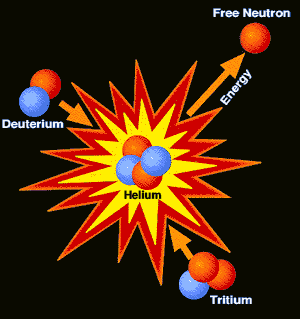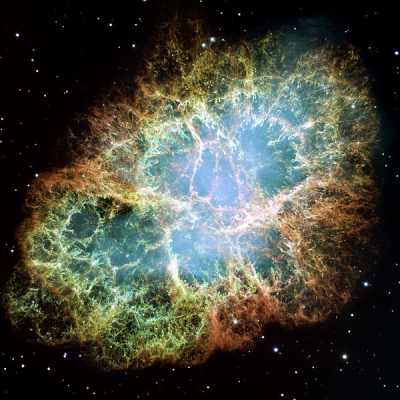
Primary sources of energy
 So where does the energy we use actually come from?
So where does the energy we use actually come from?
Radiation
In stars, hydrogen atoms undergo fusion producing helium. A very small part of the mass of these atoms is converted into energy which emanates from the sun as radiation. This is one of the two basic energy sources.
Fissionable elements
The other primary energy source is also formed in stars, but in a different way. When a star
substantially bigger than our sun runs out of fuel, its core collapses and the
star explodes in a process called a supernova. During this process, very
heavy elements can be formed that release energy when they are split. These
are called fissionables, and they are the second primary energy source.
 One should realize that nuclear fission happens naturally in every fissile
material. This is known as nuclear decay. Without this process we could
not exist, since it is this process that is largely responsible for the fact
that the earth's core is still liquid, which helps to keep us warm and
generates a magnetic field that protects us from cosmic radiation. The heat
flow from nuclear decay inside the earth is around 30 [tera][]watt. (30 000
000 000 000 Watt!)
One should realize that nuclear fission happens naturally in every fissile
material. This is known as nuclear decay. Without this process we could
not exist, since it is this process that is largely responsible for the fact
that the earth's core is still liquid, which helps to keep us warm and
generates a magnetic field that protects us from cosmic radiation. The heat
flow from nuclear decay inside the earth is around 30 [tera][]watt. (30 000
000 000 000 Watt!)
At least one instance has been found where a natural nuclear fission reactor has existed and run for a few hundred thousand years.

This work
is licensed under a Creative Commons
Attribution 3.0 Unported License.
| This post is part of our Energy Primer lunchtime series.
Read all of the entries: |
Want more in-depth information? Browse through our books.
Or explore more posts by date or by subject.
About us: Anna Hess and Mark Hamilton spent over a decade living self-sufficiently in the mountains of Virginia before moving north to start over from scratch in the foothills of Ohio. They've experimented with permaculture, no-till gardening, trailersteading, home-based microbusinesses and much more, writing about their adventures in both blogs and books.
Want to be notified when new comments are posted on this page? Click on the RSS button after you add a comment to subscribe to the comment feed, or simply check the box beside "email replies to me" while writing your comment.
